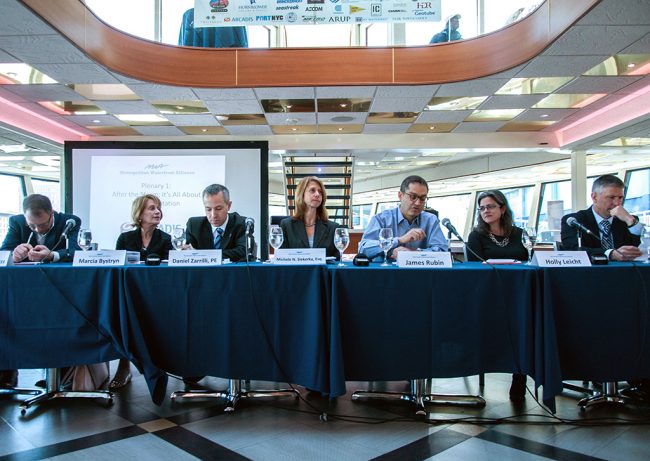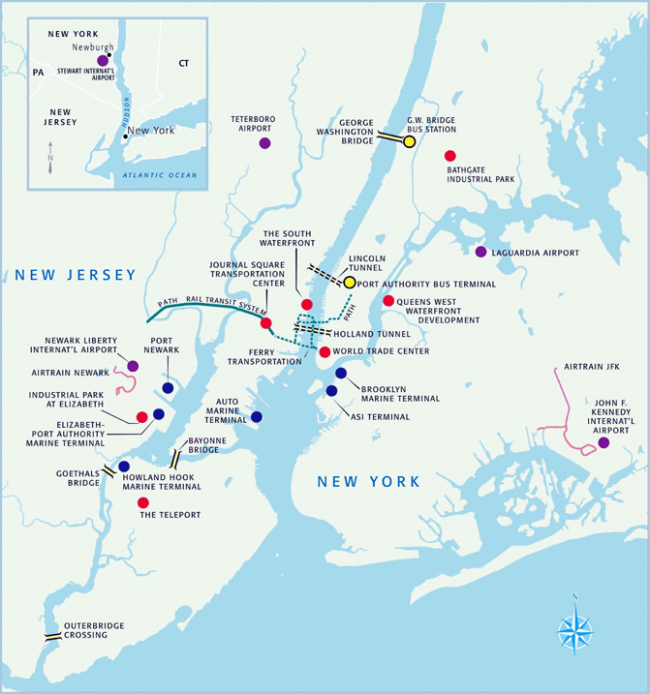
We are celebrating 15 years — and counting — of stories that are deeply researched and deeply felt, that build a historical record of what the city has been.
We are celebrating 15 years — and counting — of stories that are deeply researched and deeply felt, that build a historical record of what the city has been.

Participants in the “After the Storm: It’s All About Implementation” plenary at the MWA 2014 Waterfront Conference | Photo by Evan Simko Bednarski, courtesy of MWA
Last Thursday, four officials from the federal government, New York State, New York City, and New Jersey sat together on a boat in the Hudson River. The occasion was the Metropolitan Waterfront Alliance’s 2014 conference, titled “Rebuilding our Waterfront: From the Water In, From the Grassroots Up.” The first plenary session focused on a question of considerable interest, and consternation, for the metropolitan region: after all the studies and plans put out in the wake of Sandy, what’s actually been implemented and how does that implementation stand up against the present and future challenges they identify?
Initially, this question was met with lists of known initiatives or administration positions. Holly Leicht, Regional Adminstrator for the federal Department of Housing and Urban Development (HUD), touted the agency’s changing approach to post-disaster rebuilding exhibited by the HUD-sponsored Rebuild by Design competition. James Rubin, the director of Governor Cuomo’s office of Storm Recovery and the rebuilding initiative called New York Rising, highlighted the buyout of 400 homes on Staten Island and the recent release of 45 community reconstruction plans. New Jersey Department of Environmental Protection Deputy Commissioner Michele Siekerka made clear her state’s policy that “we don’t believe in retreat.” Daniel Zarrilli, NYC’s Director of Resiliency, stuck to Mayor de Blasio’s recently announced goal of rebuilding 500 homes and issuing 500 checks to residents who’d already done so by the summer’s end, a response to widespread disappointment with the City’s slow disbursement of recovery funds.
This rehashing of existing plans begged another question: why has the recovery lagged, and with all the talk of building resiliency into all the planned projects, do the resources to implement them exist? Leicht and Rubin chalked the delays up to new, creative approaches to disaster recovery. Leicht said this requires breaking down persistent siloes in government, more funding, and a deep cultural change in how we approach development in a future marked by climate change. Rubin also sees a need for a shift in the way we approach post-disaster recovery funding. The former private equity banker believes our political reality won’t allow for the kind of government largesse — $60 billion — that the region received after Sandy from Congress, still only half the amount he says the region needs. Rubin called for more imaginative financing solutions that utilize Wall Street and insurance companies for infrastructural investment.
The question of how to fund these big ideas spanned other discussions Thursday morning as well. Chris Ward, a former executive director of the Port Authority, explained that the Authority is no longer able to be the bank for the region, though it remains a crucial institution that should not be dismantled. The tolls and fares structure that once made it one of the wealthiest institutions around has been undermined by diversions from its core mission like the creation of the World Trade Center, said Ward. And its politicization has led to further drains on its financial capacity, as funds have been used for political pet projects. Ward says the institution needs to return to its Progressive Era underpinnings, when it was conceived as a neutral, influence-proof institution that could build the transportation infrastructure needed to support a thriving metropolitan region. But in its current state, the Port Authority barely has enough money to maintain existing infrastructure in a state of good repair.

The Port Authority of New York and New Jersey’s facilities | Map via PANYNJ
As Kyle Kimball, the president of New York City’s Economic Development Corporation, noted, new funding ideas are also needed to sustain pilot programs for expanded ferry service. The Rockaway ferry, running since Sandy, currently benefits from a $30 subsidy per passenger, which Kimball calls simply unsustainable. While the EDC hopes to build on the success of the East River Ferry, it ultimately responds to the economic viability of its projects.
The question of who will fund the abundant aspirational projects articulated for the city and region in the last 18 months is an open one, and one that will need to be answered in short order. And how these projects respond to or incorporate community waterfront plans and resident input while also addressing short-term needs, particularly following disasters, represents another balance that needs striking. Many of the plans articulated through Rebuild by Design and New York Rising notably build upon long-standing community desires for waterfront access while planning for a future that will be increasingly defined by climate change. Here’s hoping for the resources to make that kind of shift in approach permanent, and the projects it has produced possible.
The views expressed here are those of the authors only and do not reflect the position of The Architectural League of New York.